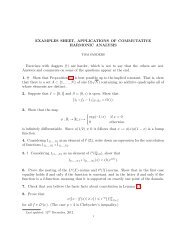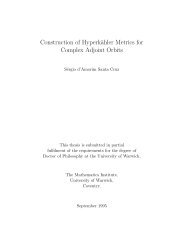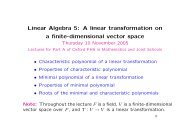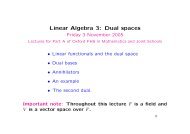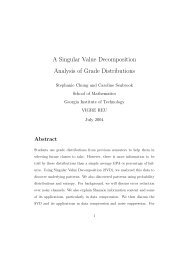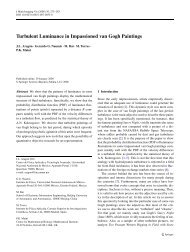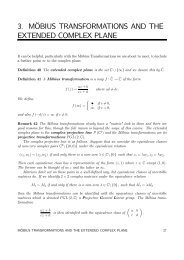Fourier Series and Partial Differential Equations Lecture Notes
Fourier Series and Partial Differential Equations Lecture Notes
Fourier Series and Partial Differential Equations Lecture Notes
You also want an ePaper? Increase the reach of your titles
YUMPU automatically turns print PDFs into web optimized ePapers that Google loves.
Chapter 2<br />
<strong>Fourier</strong> series<br />
In the following chapters, we will look at methods for solving the PDEs described in<br />
Chapter1. Inordertoincorporategeneralinitialorboundaryconditionsintooursolutions,<br />
it will be necessary to have some underst<strong>and</strong>ing of <strong>Fourier</strong> series.<br />
For example, we can see that the series<br />
∞ <br />
nπx<br />
<br />
y(x,t) = sin<br />
L<br />
<br />
nπct nπct<br />
Ancos +Bnsin , (2.1)<br />
L L<br />
n=1<br />
is a solution of the wave equation<br />
∂2y ∂t2 = c2∂2 y<br />
∂x2, x ∈ [0,L], t ≥ 0, (2.2)<br />
which satisfies the boundary conditions<br />
y(0,t) = 0 = y(L,t). (2.3)<br />
We may view y(x,t) as the solution of the problem which models a vibrating string of<br />
length L pinned at both ends, e.g. a guitar string.<br />
y<br />
0<br />
We would like to find a solution with initial conditions<br />
y(x,0) = αsin<br />
πx<br />
L<br />
<br />
,<br />
l<br />
∂y<br />
(x,0) = 0, (2.4)<br />
∂t<br />
<strong>and</strong> we do this by calculating An <strong>and</strong> Bn as follows: from equation (2.1) we have<br />
y(x,0) =<br />
∞ <br />
nπx<br />
<br />
Ansin , (2.5)<br />
L<br />
n=1<br />
9<br />
x




